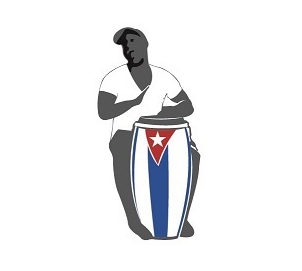Embracing the Unexpected: My Intro to Cuban Rumba
The doorways lining the streets of Cuba are sometimes like portals to a hidden treasure, and simply allowing yourself to wander around and be guided by your senses can yield some pretty unique experiences. The Marina district of Matanzas is no exception, as I discovered one afternoon while on my way to the local hair salon.
Pilar and the Rumberos
At most, the salon was a one minute walk from my casa. But about halfway there I could hear the faint sound of live drums beating out a rhythm completely unfamiliar to me. I was so intrigued that I decided to ditch my plan and follow my ears instead, down a side street to the weatherworn door of a nearby casa. As I stood there trying to peek through the cracks, I heard a voice call to me from across the street “Te gustaria entrar?” (Would you like to enter?). Pilar, as it turns out, was the owner of the casa and she was neither surprised nor offended at my nosiness. I hesitated for about three seconds while I recalled my son’s pre-trip advice to not follow strangers into their homes, but that sentiment was quickly overridden by my curiosity and I followed my new friend through her front door.
It was as though I was walking onto the set of an old war movie – crumbling stone walls, no roof, spare auto and appliance parts and miscellaneous rubble laying everywhere on the dirt floor. In the middle of all the decay were seven Cubanos sitting in a circle with congas, cajones (box drums) and other peculiar percussion instruments, playing and singing a genre of music unknown to me. This was my introduction to real street rumba in its raw and primal form. Rumba is a traditional form of Afro-Cuban music involving dancing, drumming and singing, the roots of which are believed to have originated in the streets of Matanzas and Havana. Without skipping a beat, the rumberos (rumba players) pulled up a chair for me, un-phased by the fact that I was a complete stranger, and I sat, listening and learning and appreciating being immersed in one of the most distinct elements of Cuban culture.
Kenny, hamming it up while we wait out the downpour.
30 minutes into the impromptu performance, it started to pour – not just outside but inside the house (did I mention it was May and the start of rainy season?). All instruments and people were moved in unison to the only room which had a roof, the single bedroom. But the rumba continued, and Pilar’s young son Kenny bounced around the bed hamming it up for my camera while the adults passed around a bottle of Havana Club Rum taking turns with a single shot glass. I did make an earlier attempt to leave when one of my hosts urged me to stay and wait out the deluge. At first I declined … after all, I am Canadian and we are a hearty bunch. With a shake of his head and a deep sigh, he gestured “OK, suit yourself” and opened the door. It was immediately apparent that I wasn’t going anywhere without a flotation device. The streets and sidewalks had completely disappeared and everything had been transformed into a fast-flowing river. Perfect for a white-water rafting expedition, but a walk home in flip-flops against the current? Not so much. Old leather shoes, cardboard boxes, bags of garbage, and other unidentifiable objects went rushing by as I stood there stranded and helpless. So I did the only thing possible under the circumstances – I re-joined the fiesta.
I eventually returned to my casa looking like a drowned rat, absolutely soaking wet to my core. But I had a bit of a Havana Club buzz, a rumba CD in my pocket, and a shear sense of delight at being welcomed into the fold by the resident Rumba band.
In this place, you need to embrace the opportunity to create your own detour because sometimes, the best experiences are those which happen while we’re on our way to doing something else.


